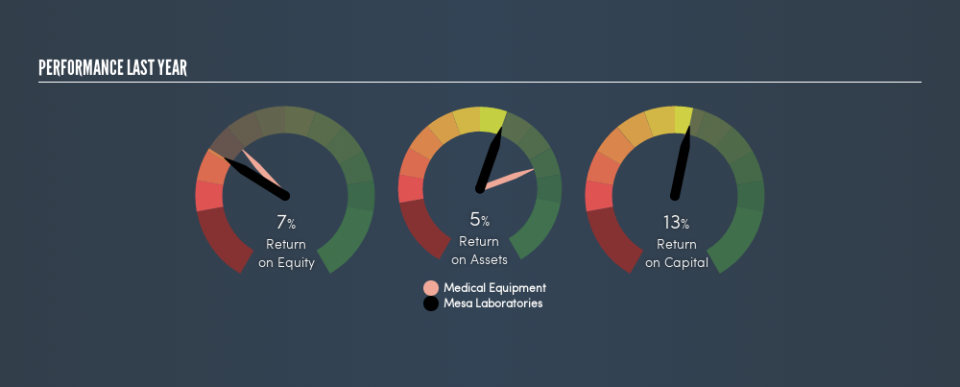Why You Should Like Mesa Laboratories, Inc.’s (NASDAQ:MLAB) ROCE

Want to participate in a short research study? Help shape the future of investing tools and you could win a $250 gift card!
Today we'll look at Mesa Laboratories, Inc. (NASDAQ:MLAB) and reflect on its potential as an investment. Specifically, we're going to calculate its Return On Capital Employed (ROCE), in the hopes of getting some insight into the business.
Firstly, we'll go over how we calculate ROCE. Second, we'll look at its ROCE compared to similar companies. And finally, we'll look at how its current liabilities are impacting its ROCE.
Understanding Return On Capital Employed (ROCE)
ROCE measures the amount of pre-tax profits a company can generate from the capital employed in its business. All else being equal, a better business will have a higher ROCE. In brief, it is a useful tool, but it is not without drawbacks. Renowned investment researcher Michael Mauboussin has suggested that a high ROCE can indicate that 'one dollar invested in the company generates value of more than one dollar'.
How Do You Calculate Return On Capital Employed?
The formula for calculating the return on capital employed is:
Return on Capital Employed = Earnings Before Interest and Tax (EBIT) ÷ (Total Assets - Current Liabilities)
Or for Mesa Laboratories:
0.13 = US$18m ÷ (US$157m - US$24m) (Based on the trailing twelve months to March 2019.)
Therefore, Mesa Laboratories has an ROCE of 13%.
Check out our latest analysis for Mesa Laboratories
Does Mesa Laboratories Have A Good ROCE?
ROCE can be useful when making comparisons, such as between similar companies. Using our data, we find that Mesa Laboratories's ROCE is meaningfully better than the 10% average in the Medical Equipment industry. I think that's good to see, since it implies the company is better than other companies at making the most of its capital. Separate from Mesa Laboratories's performance relative to its industry, its ROCE in absolute terms looks satisfactory, and it may be worth researching in more depth.
When considering this metric, keep in mind that it is backwards looking, and not necessarily predictive. ROCE can be misleading for companies in cyclical industries, with returns looking impressive during the boom times, but very weak during the busts. ROCE is only a point-in-time measure. Future performance is what matters, and you can see analyst predictions in our free report on analyst forecasts for the company.
Do Mesa Laboratories's Current Liabilities Skew Its ROCE?
Short term (or current) liabilities, are things like supplier invoices, overdrafts, or tax bills that need to be paid within 12 months. The ROCE equation subtracts current liabilities from capital employed, so a company with a lot of current liabilities appears to have less capital employed, and a higher ROCE than otherwise. To counter this, investors can check if a company has high current liabilities relative to total assets.
Mesa Laboratories has total assets of US$157m and current liabilities of US$24m. As a result, its current liabilities are equal to approximately 15% of its total assets. Low current liabilities are not boosting the ROCE too much.
Our Take On Mesa Laboratories's ROCE
This is good to see, and with a sound ROCE, Mesa Laboratories could be worth a closer look. There might be better investments than Mesa Laboratories out there, but you will have to work hard to find them . These promising businesses with rapidly growing earnings might be right up your alley.
If you like to buy stocks alongside management, then you might just love this free list of companies. (Hint: insiders have been buying them).
We aim to bring you long-term focused research analysis driven by fundamental data. Note that our analysis may not factor in the latest price-sensitive company announcements or qualitative material.
If you spot an error that warrants correction, please contact the editor at editorial-team@simplywallst.com. This article by Simply Wall St is general in nature. It does not constitute a recommendation to buy or sell any stock, and does not take account of your objectives, or your financial situation. Simply Wall St has no position in the stocks mentioned. Thank you for reading.


